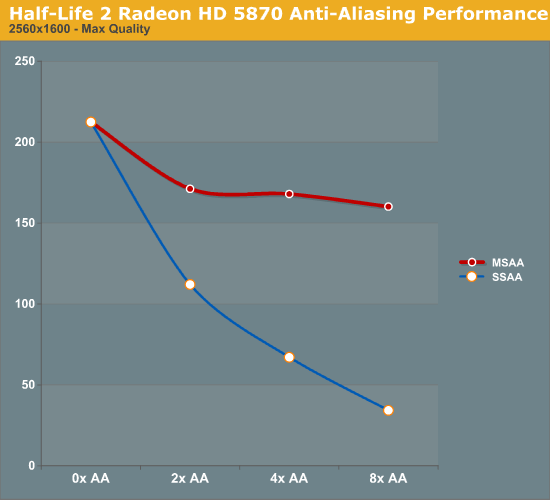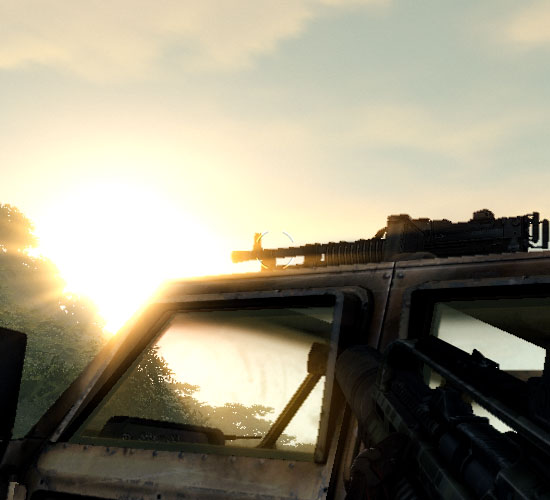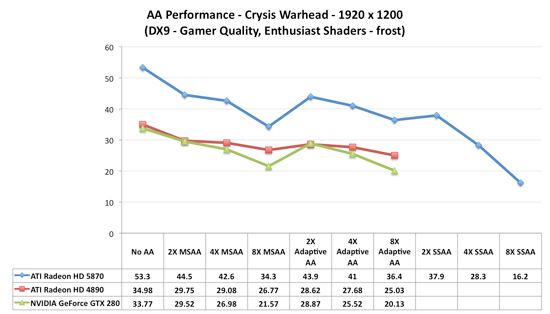AMD's Radeon HD 5870: Bringing About the Next Generation Of GPUs
by Ryan Smith on September 23, 2009 9:00 AM EST- Posted in
- GPUs
AA Image Quality & Performance
With HL2 unsuitable for use in assessing image quality, we will be using Crysis: Warhead for the task. Warhead has a great deal of foliage in parts of the game which creates an immense amount of aliasing, and along with the geometry of local objects forms a good test for anti-aliasing quality. Look in particular at the leaves both to the left and through the windshield, along with aliasing along the frame, windows, and mirror of the vehicle. We’d also like to note that since AMD’s SSAA modes do not work in DX10, this is done in DX9 mode instead.
|
AMD Radeon HD 5870
|
AMD Radeon HD 4870
|
NVIDIA GTX 280
|
| No AA | ||
| 2X MSAA | ||
| 4X MSAA | ||
| 8X MSAA | ||
| 2X MSAA +AAA | 2X MSAA +AAA | 2X MSAA + SSTr |
| 4X MSAA +AAA | 4X MSAA +AAA | 4X MSAA + SSTr |
| 8X MSAA +AAA | 8X MSAA +AAA | 8X MSAA + SSTr |
| 2X SSAA | ||
| 4X SSAA | ||
| 8X SSAA |
From an image quality perspective, very little has changed for AMD compared to the 4890. With MSAA and AAA modes enabled the quality is virtually identical. And while things are not identical when flipping between vendors (for whatever reason the sky brightness differs), the resulting image quality is still basically the same.
For AMD, the downside to this IQ test is that SSAA fails to break away from MSAA + AAA. We’ve previously established that SSAA is a superior (albeit brute force) method of anti-aliasing, but we have been unable to find any scene in any game that succinctly proves it. Shader aliasing should be the biggest difference, but in practice we can’t find any such aliasing in a DX9 game that would be obvious. Nor is Crysis Warhead benefitting from the extra texture sampling here.
From our testing, we’re left with the impression that for a MSAA + AAA (or MSAA + SSTr for NVIDIA) is just as good as SSAA for all practical purposes. Much as with the anisotropic filtering situation we know through technological proof that there is better method, but it just isn’t making a noticeable difference here. If nothing else this is good from a performance standpoint, as MSAA + AAA is not nearly as hard on performance as outright SSAA is. Perhaps SSAA is better suited for older games, particularly those locked at lower resolutions?
For our performance data, we have two cases. We will first look at HL2 on only the 5870, which we ran before realizing the quality problem with Source-engine games. We believe that the performance data is still correct in spite of the visual bug, and while we’re not going to use it as our only data, we will use it as an example of AA performance in an older title.

As a testament to the rendering power of the 5870, even at 2560x1600 and 8x SSAA, we still get a just-playable framerate on HL2. To put things in perspective, with 8x SSAA the game is being rendered at approximately 32MP, well over the size of even the largest possible single-card Eyefinity display.
Our second, larger performance test is Crysis: Warhead. Here we are testing the game on DX9 mode again at a resolution of 1920x1200. Since this is a look at the impact of AA on various architectures, we will limit this test to the 5870, the GTX 280, and the Radeon HD 4890. Our interest here is in performance relative to no anti-aliasing, and whether different architectures lose the same amount of performance or not.
Starting with the 5870, moving from 0x AA to 4x MSAA only incurs a 20% drop in performance, while 8x MSAA increases that drop to 35%, or 80% of the 4x MSAA performance. Interestingly, in spite of the heavy foliage in the scene, Adaptive AA has virtually no performance hit over regular MSAA, coming in at virtually the same results. SSAA is of course the big loser here, quickly dropping to unplayable levels. As we discussed earlier, the quality of SSAA is no better than MSAA + AAA here.
Moving on, we have the 4890. While the overall performance is lower, interestingly enough the drop in performance from MSAA is not quite as much, at only 17% for 4x MSAA and 25% for 8x MSAA. This makes the performance of 8x MSAA relative to 4x MSAA 92%. Once again the performance hit from enabling AAA is miniscule, at roughly 1 FPS.
Finally we have the GTX 280. The drop in performance here is in line with that of the 5870; 20% for 4x MSAA, 36% for 8x MSAA, with 8x MSAA offering 80% of the performance. Even enabling supersample transparency AA only knocks off 1 FPS, just like AAA under the 5870.
What this leaves us with are very curious results. On a percentage basis the 5870 is no better than the GTX 280, which isn’t an irrational thing to see, but it does worse than the 4890. At this point we don’t have a good explanation for the difference; perhaps it’s a product of early drivers or the early BIOS? It’s something that we’ll need to investigate at a later date.
Wrapping things up, as we discussed earlier AMD has been pitching the idea of better 8x MSAA performance in the 5870 compared to the 4800 series due to the extra cache. Although from a practical perspective we’re not sold on the idea that 8x MSAA is a big enough improvement to justify any performance hit, we can put to rest the idea that the 5870 is any better at 8x MSAA than prior cards. At least in Crysis: Warhead, we’re not seeing it.












327 Comments
View All Comments
T2k - Thursday, September 24, 2009 - link
Just whatF are you talking about, seriously? Is this some kind of new urban BS again?
Look at other sites, they DID test it with ET:QW:
http://www.techpowerup.com/reviews/ATI/Radeon_HD_5...">http://www.techpowerup.com/reviews/ATI/Radeon_HD_5...
http://www.xbitlabs.com/articles/video/display/rad...">http://www.xbitlabs.com/articles/video/display/rad...
and so on. BTW L4D is a passing fart in the wind while ET:QW is still going strong, stronger than UT3 (unfortunately because UT3 looks 10x better and the old ONS mode was awesome but Epic fucked it in UT3)
Read other reviews before you post:
http://forums.anandtech.com/messageview.aspx?catid...">http://forums.anandtech.com/messageview...amp;thre...
SiliconDoc - Wednesday, September 30, 2009 - link
I see by your review links the 5870 just doesn't do well in ET:QW, everything else is closer to it and it gets beat worse, at 2560 high aa&af GTX295 slams it by 20%, so, of course, it was left out, in order to "pump up the percieved red number".-
It's "not a good appearance".
You'll just have to live with it for now like the rest of us.
number58 - Wednesday, September 23, 2009 - link
Is this card any closer to saturating the pci-express 2.0 x16 slot? That was one of the big arguments in the P55 vs X58 debate. Would there be any loss of performance using these in crossfire on P55 compared to X58?Otherwise, great article. I think I'll be hanging on to my 4890 for a while though.
Kaleid - Wednesday, September 23, 2009 - link
Look here for an answer:http://www.techpowerup.com/reviews/AMD/HD_5870_PCI...">http://www.techpowerup.com/reviews/AMD/HD_5870_PCI...
number58 - Wednesday, September 23, 2009 - link
Thanks. That just about settles it. My next system will be Lynnfield based.Zeratul - Wednesday, September 23, 2009 - link
Please add support for Stereoscopic 3D, ATI. I'm not going back to play games in 2D, though I don't like nvidia's monopoly in that.Arbie - Wednesday, September 23, 2009 - link
Not just a review but an excellent technical discussion. It must have been a lot of work. Thanks for all of that, and do please follow up where you can on people's requests for more info on this very important card.Kudos to ATI/AMD for such an achievement. It looks like Nvidia is in big trouble.
Arbie
SiliconDoc - Wednesday, September 23, 2009 - link
rofl - Nvidia is in big trouble ? LOLHave you looked at the charts on wiki that predicted what this review shows ? Maybe you should take a gander at the Nvidia chart, now, and cry.
--
It is a nice review, although biased red here as usual.
--
I'd like to mention as he fretted about heat because of the 1/2 vent on the back of the card, I didn't notice overt despairing mention of the TWO rectangular exhaust ports on the fan end BLOWING HEAT INTO THE CASE.... which of course is deserved. Nice how that was held back as if overlooked. (Boy what trouble for Nvidia! hahha)
Next we'll be told the red rooster tester put his hand next to the two internal exhaust ports, and "the air felt rather cool" so "rest assured not much heat is being pushed into your case", and "this doesn't matter".
See, the trouble is already in the article, the trouble it took to spin it just so for Ati... lol... it's hilatrious!
ClownPuncher - Wednesday, September 23, 2009 - link
Bizzarro SnakeOil, is that you?SiliconDoc - Wednesday, September 23, 2009 - link
No, this is me, the same me I've always been.Would you like to comment on the two internal exhaust ports of the 5870 that put sweltering heat into your case ?
I guess you tried to ignore that entirely.
You can always insult me again and avoid commenting on the heating exhaust ports ramping up your case temps on the 5870...
That of course would be "the right thing to do".
Perhaps call me crazy, and avoid the topic, right, you're good at that, huh.